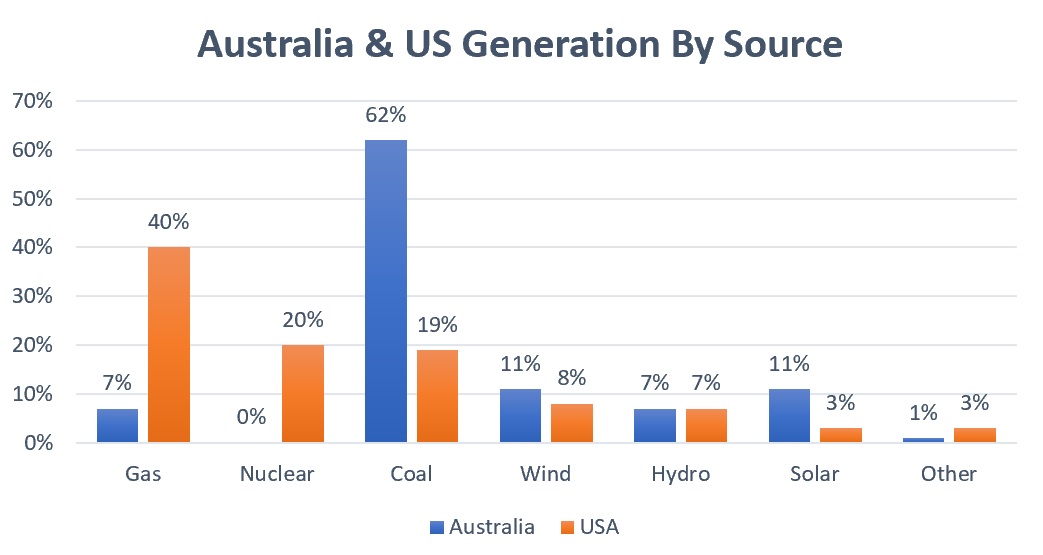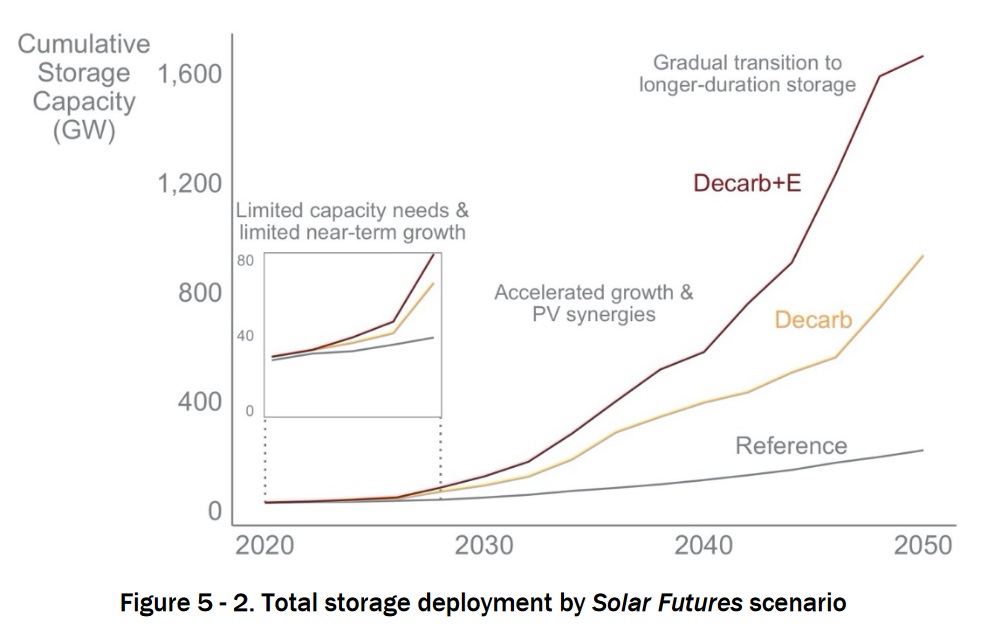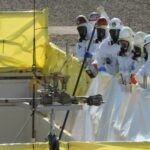Biden Wants US To Go 40% Solar By 2035


You may have noticed the US President is looking less orange these days. Now that “sleepy” Joe Biden is in the White House’s egg-shaped office, American climate change policy is moving in the right direction.
The good news is — compared to Australian policy — the US isn’t just taking steps in the right direction, it’s breaking into a lumbering gallop. A week and a half ago, the US Department of Energy released the Solar Futures Study that outlines how the US will cut grid emissions 95% by 2035.
Solar power will do the heavy lifting. Biden wants to increase solar energy generation from today’s 3% to an impressive 40%.
This isn’t political hot air. Unlike Australia, where our Prime Minister claims to want zero emissions by 2050 but actively works against it, the Biden administration intends to go the distance. It’s a huge job to get done in little more than 13 years, but the United States is more than up to the task. When they put their mind to it, the world’s largest economy1 can achieve astounding things. This is a nation that was producing nearly one aircraft carrier a week by the end of World War 2.2
It’s a big plan and so comes with a big report. There’s a summary here or you can download the whole 279 page schmear here.
The massive report looks at two different scenarios beyond “business as usual”:
- Decarb: This is where grid emissions are cut at least 95% by 2035 but assumes electricity consumption increases in line with current estimates.
- Decarbonization with Electrification: This is decarb on steroids. It involves the same 95% cut to grid emissions by 2035 and a large increase in clean electricity production to rapidly replace fossil fuels in areas such as transport, home heating, and industry.
I’m going to focus mainly on the grid and the decarb scenario because the report is so long I can’t cover everything. But I do expect emissions outside of the electricity sector will also rapidly decrease. After all, electric cars in the US aren’t a passing fad like they were in 1903.


US Emissions
The United States has the second-highest greenhouse gas emissions. Coming second is nothing to be proud of given that the winner — China — has over four times the population.
Per capita, the US is double the emissions of China. The only nation with higher per capita emissions than the US that isn’t a net oil exporter is the country of Let’s Change the Subject3.
Currently, 25% of US net greenhouse gas emissions are from its grid. In coal-heavy Australia, it’s over 30%.
A Tale Of Two Countries
The graph below shows grid generation by source for Australia and the US:


Australia’s coal generation stands out, as our portion is over three times higher. In the US, instead of burning coal like it’s going out of fashion — which it is — they use a lot of natural gas. As a percentage, gas generation is around six times higher than it is here and they get infinity times as much from nuclear.
US wind power is the cheapest in the developed world, but they’re still behind us. We’re also well ahead on solar power, with more on rooftops. The percentage of solar generation that is distributed and mostly installed on rooftops is…
- Australia: 74% on rooftops
- US: 31% on rooftops
The two countries appear neck and neck on hydro, but 7% is higher than figures I’ve seen for US hydro in the past, so take it with a grain of salt4.
The Plan: More Wind & Solar Power
The plan is for the US to eliminate most coal and gas electricity generation by 2035 through increasing…
- Solar to around 40% of generation, and…
- Wind to around 36% of generation
No significant increase is expected in any other form of electricity generation. This will result in around 76% of US electricity coming from wind and solar power. This appears more than enough to eliminate fossil fuels from the grid that currently generate 59% of US electricity, but around 5% of generation is expected to still be generated from fossil fuels — almost entirely natural gas — in 2035. One reason why the massive growth in renewables won’t wipe out fossil fuels is that nuclear generation will decline.
Nuclear Power In Decline
Nuclear, a low emission source of energy, will shrink from 20% of US generation today to around 12% in 2035. A small portion of the decline will be from increased electricity consumption, but it is mostly due to old reactors being shut down and not replaced. There are only two new reactors under construction in the United States and both are at a single nuclear power station.
Nuclear power is going to decline because it’s expensive and, unlike gas generation, saves very little in fuel and operation costs by shutting down during periods of high solar and wind energy output. I put the chances of nuclear reversing its decline in US — with very little rounding — at 0%.
Massive Gas Capacity Eases Renewable Integration
In Australia, to shut a coal power station, two things are necessary:
- Enough solar and wind capacity must be built to replace all or most of the coal power electricity generation.
- Enough dispatchable sources of electrical energy must be added to firm the grid when solar and wind output is low.
At the moment, the second part is easier in the US than here because they have extensive gas generation, which is far easier to ramp up and down than coal.
Energy Storage
While gas generation will ease the transition to renewables, energy storage will also rapidly expand, and may be able to provide 350 gigawatts of power by 2035. That’s around one kilowatt for every person in the United States. There will only be enough energy stored to supply that much power for a few hours, but this will still be enough to mostly decarbonize the US grid.


Long Distance Transmission
You’d think with 13 times Australia’s population density, the main blob of the United States would already be well integrated with lots of long-distance transmission, but that’s not the case. The US is divided into a number of large grids with limited or no electricity transmission between them. To get power where it’s needed and to geographically disperse renewable energy generation across an area the size of Australia, the study says inter-regional transmission will increase 60% by 2050.
Solar Energy Resources Often Better Than Australia
Most people think Australia is a much better location for solar power than the US. This is because they look at solar insolation maps and see Australia is almost all and red while the US has a lot more yellow and some green.

Image: Global Solar Map. (Note image taken that week Australia and Hawaii swapped places.)
In practice, it’s often not the case. Perhaps 100 million Americans have better access to solar resources than Australians.
This is because when the British first rocked up to Australia, they were very pasty and — even though they didn’t have a good understanding of skin cancer back then — they instinctively knew the big burny thing in the sky wanted to kill them. Because of this, they quite intentionally built colonies in the cloudiest places they could find.
In the US, people in cities such as Los Angeles, Phoenix, Albuquerque (yes, there really is a place called Albuquerque) and many others all have more solar insolation falling on their rooftops than in any Australian capital5. As roofs are often the best place to put solar panels, this is very useful. There’s also a lot more existing transmission capacity in the sunnier parts of the country than here, which is handy for solar farms.
There are parts of the United States with low solar output such as Seattle. But even there isn’t nearly as bad as Edinburgh, where the natives throw slices of deep-fried pizza at the sun in superstitious fear during the 15 minutes a year it’s visible. Fortunately, low insolation in some parts of the US is not a problem for solar deployment. They can make use of rooftop solar panels even with relatively low insolation, and they can make use of long-distance transmission to get power from places like Albuquerque.
More Solar Panels No Problem
The plan involves a massive increase in solar capacity:
- The rate of PV installation will increase four times to 30 gigawatts per year from now through to 2025.
- This will then double to 60 gigawatts a year after that: eight times the current rate.
The main focus of the study is solar, as it will be around two-thirds of the new generating capacity. Many hectares of paragraphs are devoted to pointing out potential obstacles such as…
- Land for solar farms
- Raw materials required
- Solar waste
- Technological development
…are not show stoppers.
Land For Solar Power
The study says the amount of land solar requires will cover 0.5% or less of the contiguous United States between Canada and Mexico. That doesn’t sound like much, but it’s a massive amount — 40,000 square kilometres. That’s the size of Denmark and four and a half times Yellowstone National Park where Yogi Bear lives.

Meanwhile, Smokey Bear has something to say to you coal-burning hairless apes.
But, as I’ve pointed out before, coal also takes up a massive amount of land and natural gas extraction takes up a considerable amount in the US. Also, they’ll lose a lot more than 0.5% of their land if we don’t stop the ice caps melting. The report says there is more than enough land available for solar that’s either contaminated or unsuitable for most other purposes.
My guess is 40,000 square kilometres is way more than they’ll actually need. In Australia just under three-quarters of our solar energy generation comes from rooftops and there’s no reason the US can’t do much the same. Technically, all the new solar generation could go on rooftops, but that’s not likely to happen. If half of it ends up there they’ll only need 20,000 or so square km for solar farms, which is little more than two Yellowstone Parks — or in practice, a lot of contaminated wasteland.
The report does not distinguish between utility-scale solar farms and distributed solar. It’s completely panel location agnostic. It just says a lot of solar capacity will be installed and says there’s enough wasteland if it goes in solar farms, but doesn’t attempt to specify where it will end up.
Raw Materials
The report says there are enough raw materials to build the solar capacity. You only have to look at all the material goods Americans go through in a year to see that’s true. The quintessential American is someone who drives a Hummer and asks if there are enough resources for America to go renewable.
The main components of solar panels are glass, silicon, and aluminium. We’re not about to run out of them. Even, if we were, recycling is an option.
Solar Waste
The study says waste material from solar power will not be a problem. One reason given is because it can be recycled. Reuse is also mentioned. I presume this means sending used panels to poor countries: something that already happens. If they’re talking about turning them into coffee tables, I’m not sure the market for them will be high enough.
The report also mentions repair. That’s generally not something that happens with solar panels. It’s normally a case of remove and replace.
There is no reason why we can’t recycle solar waste. It is a good idea to clean up after ourselves. But if we didn’t, I don’t think future generations would give much of a shit. We could throw every solar panel ever made into the hole left by a single coal mine and have room left to spare. I think the people of the future would be more pissed off if we left them with sea-level rise and killer heatwaves than a giant pit full of broken panels.
The problem of solar waste isn’t something that should be ignored but is trivial compared to the problem it solves.
Technological Development
The report says:
“Continued technological progress is critical to achieving the Solar Futures vision.”
I was going to say that’s bullshit. After all, South Australia electricity generation is 62% renewable as a percentage of state consumption and there is nothing stopping it from getting to 95% with current technology. But after thinking about it, I’ve decided it’s more of an exaggeration.
It would be more correct to say that to achieve their vision at the cost they want, then renewable generation and energy storage will need to continue to fall in cost. But even if costs never fell by another cent from what they are today, the vision can still be achieved. They’d just have to throw a little money into the pot. When your goal is to stabilize the earth’s climate for the sake of future generations, you don’t give up just because it may mean you have to wait a year before buying a new car.
But even if — for some strange reason — there were no new technological advances, just applying ones that have already been made and economies of scale from increased production will be enough to considerably lower costs. While I expect it will get harder to squeeze cost reductions out of conventional silicon solar in the future, there’s no reason to think we won’t have any more bright ideas.
No Increased Cost
Back in 2000, if you’d told me the US was going to cut its grid emissions 95% by 2035 I would have automatically assumed this was being done with a sensibly implemented carbon price. But this is not part of the plan.
Thanks to the hard work of millions of people around the world — including the Australian solar power industry — renewable generation and energy storage have fallen so far in cost, cuts in emissions will be achieved without a carbon price and no increase in electricity costs through to 2035.
A carbon price is still a good idea – just not necessary. If required, the US can regulate the greenhouse gas emissions of generators under their Environmental Protection Act6. The rest of the work will be done by renewables and storage smashing fossil fuels on price.
The study estimates $1.5 trillion Australian dollars will be saved by 2050 from reduced costs from pollution and climate change. If they go the whole hog and pursue the ‘Decarbonization with Electrification’ scenario, this increases this to $2.3 trillion Australian.
Some Weird Stuff
The study gets all the basics right:
- Renewable capacity — mainly solar power — will increase dramatically.
- Only hours of energy storage will be needed to cut grid emissions by 95% — not days or months.
- The cost will be low and electricity prices need not increase.
But the study also goes into some things that are unlikely to pan out such as some speculative forms of energy storage. I don’t think it was necessary to include this stuff. It’s not as if the study was in danger of being too thin without it.
America is a capitalist nation, or at least cosplays as one7, so if companies or individuals want to invest in some long-shot technology that will have a great payoff if it works, they can. Provided investors are clear that fossil fuels are being shown the door no matter what, this will happen naturally. There’s no need to include various pie in the sky projects in the report.
I presume the reason they’re there is to keep various people happy and build up support. After all, getting your pet project mentioned in the study will probably help set up future opportunities for some old fashioned, Yankee, crony capitalism.
Australian Policy Is Way Behind
I’m very happy the Biden Administration intends to slash emissions and massively expand renewable energy generation. It’s not an Australian PM promise where our leadership says they want zero emissions but refuses to hold a hose on practical measures to get us there and wouldn’t even piss on you if you were on climate change related fire.
The US plan to slash grid emissions will put the Australian government under pressure to do the same instead of trying to prolong coal burning for as long as possible. While I may be too optimistic, it makes me think my grandchildren may be left with a decent planet to live on and won’t be cursing me for being part of the generation that willfully trashed the place. Instead, I sincerely hope they’ll be cursing me for blowing their inheritance on hookers.

It may not look like much, but this collector’s item is worth $23,000. (Image: Outdoorhub)
While I’m confident Australia’s transition away from coal will occur much faster than most expect, if our government succeeds in too much delay, we may find ourselves hit with climate-related trade tariffs from countries such as the US and China. Both of them enjoy having an external enemy they can rattle sabers and sanctions at, but I’d prefer it if we weren’t setting ourselves up to be a climate scapegoat. Unfortunately, our national current policy isn’t just in the stone age, it’s stuck in the carboniferous.

It’s not that Scott Morrison is a bad person, he’s just nostalgic for the days when he could take a stroll through the bush without any clothes on.
It’s always possible the United States will vote in another tangerine scream machine who’ll claim to want to save coal. But Trump said that and he did bugger all. So I’m hoping any future idiot President will only slow rather than prevent the elimination of fossil fuels.
Taking strong action to cut emissions is an excellent way for the United States to regain some of its lost credibility. I don’t know if the US will ever regain the superpower status it used to have, but being a competent major power is a hell of a lot better than being a supervillain.
Footnotes
- World’s largest economy, nominal. China is larger by PPP or Purchasing Power Parity. But nominal is probably more important here, since they’ll be buying lots of solar panels from China.
- They were mostly small escort carriers but even a small aircraft carrier is still pretty big.
- Okay, it’s Australia! Australia is the largest CO2 emitter per capita in the non-oily world. It’s not a good thing to be.
- While the US has a lot more rain and is a lot less flat than Australia, their higher population normally means they generate a smaller portion of electricity from hydro than we do. The reason the current figures are so similar could be because past figures were wrong, it may include pumped hydro which is energy storage and not generation, it could include hydroelectricity imports from Canada, or maybe they’ve just had a lot of rain lately.
- PVWatts says, compared to Perth, rooftop solar power in Los Angeles will produce 1% more, in Phoenix 4% more, and in Albuquerque 8% more.
- Even US judges probably won’t be able to successfully claim only some of the harmful gases coming out of a smokestack can be regulated.
- The US is crony capitalist. Biden seems to be against this — but not when it comes to traditional pigs in barrels, such as nuclear submarines.
Original Source: https://www.solarquotes.com.au/blog/biden-usa-solar-goal/



















